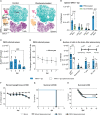Clodronate is not protective in lethal viral encephalitis despite substantially reducing inflammatory monocyte infiltration in the CNS
- PMID: 37545511
- PMCID: PMC10403146
- DOI: 10.3389/fimmu.2023.1203561
Clodronate is not protective in lethal viral encephalitis despite substantially reducing inflammatory monocyte infiltration in the CNS
Abstract
Bone marrow (BM)-derived monocytes induce inflammation and tissue damage in a range of pathologies. In particular, in a mouse model of West Nile virus (WNV) encephalitis (WNE), nitric oxide-producing, Ly6Chi inflammatory monocytes from the BM are recruited to the central nervous system (CNS) and contribute to lethal immune pathology. Reducing the migration of these cells into the CNS using monoclonal antibody blockade, immune-modifying particles or CSF-1R inhibitors reduces neuroinflammation, improving survival and/or clinical outcomes. Macrophages can also be targeted more broadly by administration of clodronate-encapsulated liposomes, which induce apoptosis in phagocytes. In this study, clodronate reduced the inflammatory infiltrate by 70% in WNE, however, surprisingly, this had no effect on disease outcome. More detailed analysis demonstrated a compensatory increase in neutrophils and enhanced activation status of microglia in the brain. In addition, we observed increased numbers of Ly6Chi BM monocytes with an increased proliferative capacity and expression of SCA-1 and CD16/32, potentially indicating output of immature cells from the BM. Once in the brain, these cells were more phagocytic and had a reduced expression of antigen-presenting molecules. Lastly, we show that clodronate also reduces non-myeloid cells in the spleen and BM, as well as ablating red blood cells and their proliferation. These factors likely impeded the therapeutic potential of clodronate in WNE. Thus, while clodronate provides an excellent system to deplete macrophages in the body, it has larger and broader effects on the phagocytic and non-phagocytic system, which must be considered in the interpretation of data.
Keywords: CNS infection; bone marrow monopoiesis; clodronate; macrophage depletion; monocyte-derived cells; monocyte-mediated inflammation; neuroinflammation; virus-induced encephalitis.
Copyright © 2023 Spiteri, van Vreden, Ashhurst, Niewold and King.
Conflict of interest statement
The authors declare that the research was conducted in the absence of any commercial or financial relationships that could be construed as a potential conflict of interest.
Figures




Similar articles
-
PLX5622 Reduces Disease Severity in Lethal CNS Infection by Off-Target Inhibition of Peripheral Inflammatory Monocyte Production.Front Immunol. 2022 Mar 25;13:851556. doi: 10.3389/fimmu.2022.851556. eCollection 2022. Front Immunol. 2022. PMID: 35401512 Free PMC article.
-
Ly6c+ "inflammatory monocytes" are microglial precursors recruited in a pathogenic manner in West Nile virus encephalitis.J Exp Med. 2008 Sep 29;205(10):2319-37. doi: 10.1084/jem.20080421. Epub 2008 Sep 8. J Exp Med. 2008. PMID: 18779347 Free PMC article.
-
Temporal tracking of microglial and monocyte single-cell transcriptomics in lethal flavivirus infection.Acta Neuropathol Commun. 2023 Apr 4;11(1):60. doi: 10.1186/s40478-023-01547-4. Acta Neuropathol Commun. 2023. PMID: 37016414 Free PMC article.
-
Inflammatory monocytes and the pathogenesis of viral encephalitis.J Neuroinflammation. 2012 Dec 17;9:270. doi: 10.1186/1742-2094-9-270. J Neuroinflammation. 2012. PMID: 23244217 Free PMC article. Review.
-
The plasticity of inflammatory monocyte responses to the inflamed central nervous system.Cell Immunol. 2014 Sep-Oct;291(1-2):49-57. doi: 10.1016/j.cellimm.2014.07.002. Epub 2014 Jul 11. Cell Immunol. 2014. PMID: 25086710 Free PMC article. Review.
Cited by
-
Depletion of macrophages and osteoclast precursors mitigates iron overload-mediated bone loss.IUBMB Life. 2025 Jan;77(1):e2928. doi: 10.1002/iub.2928. Epub 2024 Nov 18. IUBMB Life. 2025. PMID: 39555707 Free PMC article.
-
Temporally resolved single-cell RNA sequencing reveals protective and pathological responses during herpes simplex virus CNS infection.J Neuroinflammation. 2025 May 31;22(1):146. doi: 10.1186/s12974-025-03471-x. J Neuroinflammation. 2025. PMID: 40450318 Free PMC article.
-
Glycolytic shift during West Nile virus infection provides new therapeutic opportunities.J Neuroinflammation. 2023 Sep 27;20(1):217. doi: 10.1186/s12974-023-02899-3. J Neuroinflammation. 2023. PMID: 37759218 Free PMC article.
References
-
- Getts DR, Terry RL, Getts MT, Müller M, Rana S, Deffrasnes C, et al. . Targeted blockade in lethal West Nile virus encephalitis indicates a crucial role for very late antigen (VLA)-4-dependent recruitment of nitric oxide-producing macrophages. J Neuroinflamm (2012) 9:246. doi: 10.1186/1742-2094-9-246 - DOI - PMC - PubMed
Publication types
MeSH terms
Substances
LinkOut - more resources
Full Text Sources
Medical
Research Materials
Miscellaneous

